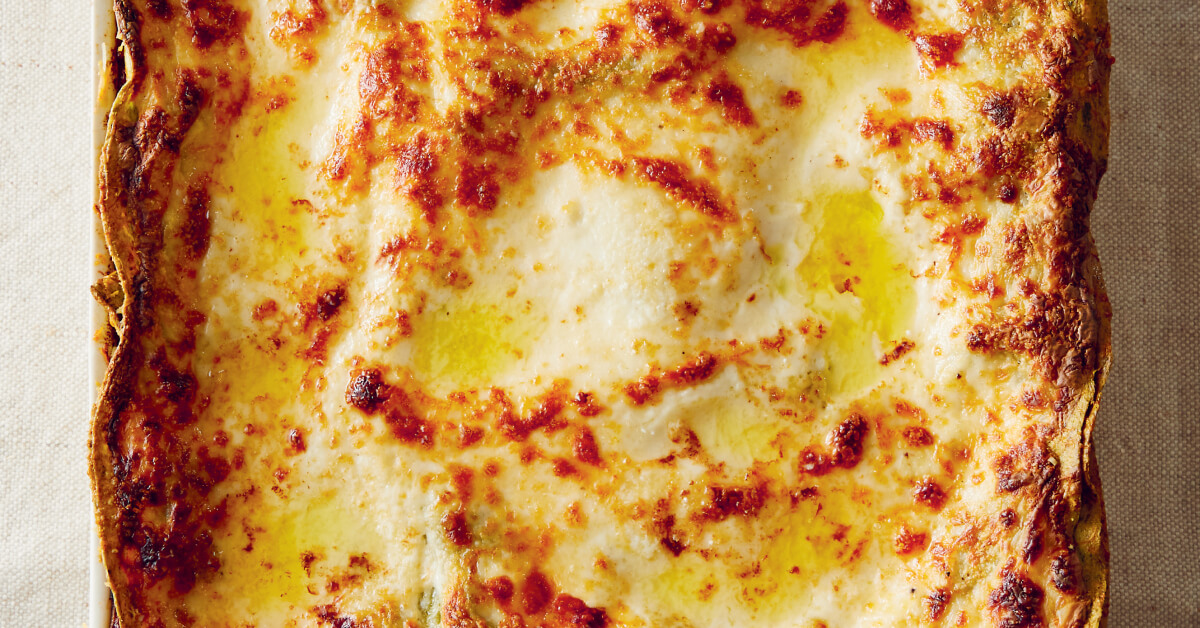Recipe & pairing | Julia Busuttil Nishimura's (Good Cooking Every Day) Lasagne

We’re huge fans of Julia Busuttil Nishimura’s uncomplicated, seasonal cooking. Her latest collection "Good Cooking Every Day" (available now!) is exactly that; packed full of deliciously relaxed recipes for everyday eating at its very best. Here’s her recipe for a year-round comforting classic lasagne. And the wine? We’ve got a few winning suggestions there, too.
Pairing tip: “Your classic Italian tannic, refreshing reds are what you're probably expecting - your sangiovese, langhe nebbiolo, super tuscans et al - but for me a rich, ripe, rounded chardonnay or chenin blanc is the real winner. Something with the body to compete with the warming weight of beef, besciamella and parmesan, and a lick of acid to stave off the food coma (at least for a little while). And whaddya know, the ingredients also call for a glass of white - so one for the dish, and plenty more left to share around the table too. Saluti.” - Nick
Try this with:
Chardonnay 2023 - Black Market Deal #50374
This is everything you would want from a bold and boisterous Margs chardonnay. There’s concentration, minerality, funk, citrus acidity and an undertone of struck match. This wine routinely features in our staff and mofo favourites each year, and we never seem to have enough of it - so if you're reading this, jump on it quick (before we snap it all up for ourselves).
Juniper Cornerstone Wilyabrup Chardonnay 2022
So rich. So generous. So utterly compelling. A wine you can't put down. It changes so much in the glass, offering little pockets of intrigue as it evolves - this is a wine for the ages. Lemon curd and meringue at the core, with flashes of green pear and mint at the edges. Bright acidity picks up and drives the wine, and the finish is marked by bountiful minerality. This has premium, no-expense-spared winemaking stitched into every fibre of its being. From lashings of new french oak to strict fruit selection. This is beautifully composed in every way.

Lasagne
Homemade lasagne is a labour of love, but what beautiful rewarding labour. It is what I make when I want to unwind and really sink into cooking for an afternoon. It is for Sundays when it’s rainy outside, all the windows foggy from the kitchen warmth. Here the pasta dough is enriched with spinach for a vivid green that holds the rich ragù and besciamella. I buy the Parmigiano Reggiano already grated from my local deli. That is one kitchen task I don’t particularly enjoy, especially when making lasagne. If you want to make regular pasta, simply use the ratio of 1 egg to 100 g of flour. The spinach in the dough makes the pasta a little more delicate to work with, so take care.
SERVES 8–10
INGREDIENTS:
125 g flat pancetta, diced
1 onion, very finely diced
1 carrot, very finely diced
1 celery stalk, very finely diced sea salt
1–2 tablespoons extra-virgin olive oil, if needed
300 g pork mince
200 g beef mince
1 garlic clove, crushed with the side of a knife
1 rosemary sprig
1 fresh bay leaf
4 sage leaves
150 ml dry white wine
700 g tomato passata
500 ml (2 cups) chicken stock 2 cloves
150 g Parmigiano Reggiano, grated
SPINACH PASTA DOUGH
150g English spinach leaves 3 eggs
400g tipo 00 flour
pinch of sea salt
semolina flour (semola rimacinata), for dusting
BESCIAMELLA
1 litre full-cream milk
80 g unsalted butter, plus
extra for greasing and dotting
80 g plain flour
good pinch of freshly grated nutmeg sea salt and black pepper
RECIPE
Place the pancetta in a large saucepan over a medium heat and cook for 3–4 minutes or until beginning to colour and the fat has rendered out. Add the onion, carrot, celery, a pinch of salt and some olive oil, if needed, and cook for 10–12 minutes or until the vegetables are soft and beginning to colour. Increase the heat to high, add the pork and beef minces, breaking the meat up with the back of a wooden spoon, and cook for 6–7 minutes or until browned. Add the garlic and herbs and stir well to combine. Deglaze with the wine, scraping the bottom of the pan to lift any brown bits, and simmer for 1–2 minutes to let the alcohol evaporate. Add the tomato passata, stock and cloves and bring to the boil. Reduce the heat to low and cook, covered, for 1 1⁄2–2 hours or until the ragù is thick and rich. If the ragù becomes too dry during cooking, a little water can be added.
For the spinach pasta dough, blanch the spinach in salted boiling water, then drain, refresh in iced water and drain again. Place in a food processor with the eggs and blitz until smooth. Alternatively, finely chop the blanched spinach and mix with the eggs in a small bowl. Tip the flour and salt onto a clean work surface and combine with your hands. Create a well in the centre, pour in the spinach mixture and gently whisk with a fork. Slowly bring in the flour and mix to incorporate. When the dough becomes stiff, use your hands to finish bringing the dough together. Knead for 10 minutes or until the dough is smooth and elastic. You want to knead with a rocking motion, pushing the dough away from you, then bringing it back to the middle, rotating it 90 degrees, then repeating. This encourages a smooth surface and a nice round shape. Cover with an upturned bowl and rest at room temperature for at least 30 minutes.
On a lightly floured work surface, roll one-quarter of the dough into a rough disc around 1 cm thick. (Cover the remaining dough with the upturned bowl.) Roll the dough through a pasta machine through the widest few settings. Fold the dough into the centre from both of the shortest sides, like you’re closing a book, then rotate it 90 degrees. Repeat this a few times through the first few settings to encourage the pasta to form a sheet and help make the pasta strong. Now roll the dough continuously through the settings until the pasta is around 0.8–1 mm thick. Repeat with the remaining dough. Cut the pasta sheets into 30 cm lengths and dust with semolina flour, if needed.
Blanch the pasta sheets, a few at a time, in plenty of salted boiling water for 1 minute. Refresh in a bowl of iced water, then place them on clean tea towels. It is important that the cooked lasagne sheets do not touch each other as they will stick.
For the besciamella, warm the milk in a saucepan to just below simmering point; you don’t want it to boil. In another saucepan, melt the butter over a medium heat and sprinkle in the flour. Whisk to form a roux and cook until the roux starts to colour, around 1–1 1⁄2 minutes. Pour in the hot milk, whisking constantly to avoid any lumps. Reduce the heat to low and cook until the besciamella has thickened and coats the back of a wooden spoon, around 8–10 minutes. Stir in the nutmeg and season to taste.
Preheat the oven to 180°C fan-forced.
Grease a 30 cm square baking dish with butter and spread a small layer of ragù over the base. Add a pasta sheet, then a more generous spoonful of ragù. Top with some besciamella and a good scattering of Parmigiano. Continue until all the ingredients have been used, finishing with a layer of pasta, ragù, besciamella and plenty of Parmigiano. In this size dish, you will have six to seven layers. A larger dish will produce a shorter lasagne.
Dot the top of the lasagne with some extra butter and bake for 35–40 minutes or until golden and bubbling. Allow to sit for at least 10 minutes before serving.
This recipe is an extract from “Good Cooking Every Day” by Julia Busuttil Nishimura, available now.

